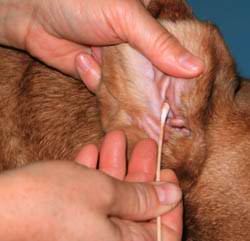Feline distemper infections tend to be quite different from
canine distemper. In fact they are caused by a completely separate virus.
Feline Distemper, also called panluekopenia, is caused by a parvo virus. (This
is a different parvo virus then the one found in dogs). It is one of the most
common conditions we vaccinate kittens and adult cats against.
The Distemper or panleukopenia virus can be found anywhere.
Almost all cats will become exposed to this virus at some point in their lives.
As with many illnesses the very young, immuno-compromised and the old are most
susceptible. It is highly contagious so large populations of cats may also be
more likely to contract this virus.
Being particularly tough, this virus can be difficult to
kill. It actually takes bleach to rid an infected area. (1 part bleach, 32
parts water) Typically a cat will pick it up from the secretions of another
cat. It will first contact the mucous membranes of their nose and mouth then
continue throughout the body.
Cats affected with this virus can become quite sick. It
tends to attack rapidly dividing cells which includes intestines, bone marrow
and in growing kittens their brain. Symptoms can range from diarrhea, to lower
(almost nothing) white blood cell count on bloodwork OR if they are infected
when they have not even been born they can show completely different symptoms.
If a mother cat contracts the virus and is not vaccinated depending on where
she is in her gestation she could abort the fetuses or they can be born with
neurologic deficits. This is known as cerebellum hypolasia.
Treatment as with parvo virus in puppies is supportive care.
They need to be kept warm, and control any secondary conditions and ensure they
do not become dehydrated. Usually there is no lasting side effects. It is
important to remember that even if the patient is acting normally they could
still be shedding the virus for awhile after symptoms stop.
Again the good news is there is a vaccine that helps prevent
this infection from getting out of hand. The FVRCP vaccine is boostered in
kittens regularly and also protects against certain upper respiratory viruses
that cause sneezing and coughing, but more importantly helps protect them from
panleukopenia. Once they are done with their kitten booster series, depending
on the clinic protocol and cat’s risk factors it may be that your vet switches
to the three year protocol where this vaccine is given every three years. For
more information you can visit Veterinary Partner
here.
































